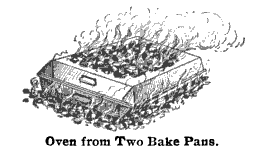from Practical Hints on Camping
"The
French cook marvelous dinners over two or three little square holes, filled
with burning charcoal, and this has suggested the following method, which
experience has proved at times to be most excellent. Have the main fire in a
good state, but not too large. Take from it a few live coals, and build three
small fires near by, and close to each other. The main part of your dinner is
prepared over these small fires. They are more easily kept at a uniform heat;
you are much freer from heat and smoke; there is not as much danger of
upsetting, and each dish having a distinct fire by itself, there is less
confusion. This method will be found not only more convenient, but also has the
advantage of cooking a greater number of dishes at the same time, and with
little trouble.
T. S. Updegraff suggests a fire-place made as follows: "Pile up a
lot of stones, about a foot high and four feet long. Build a wing on each end
two feet long. Cover the stones with sod and earth. Now place bars of iron
across the top of this upon which to set your cooking utensils."
Henderson, Howard. Practical Hints on Camping. Chicago: 1882
The
Complete American and Canadian Sportsman's Encyclopedia
"Select two medium thick green logs and level off with the camp axe the
top as shown in the engraving. Set and brace these logs a few inches apart,
only so as they will form support on which the bottom of your utensil will rest
safely; scrape out a little trench underneath and with a few pieces more form
the windguard or radiator shown in illustration and, lo! your splendid camp
range is complete.
[Improvising ovens]
Don't think you must have a range or stove to have a good oven. As good
an oven as can be built is made by the simple plan of taking two sufficiently
large plates—common baking pans or stew kettles; one a trifle larger than the
other, so as to be inverted over each other easily; fit them first so as to be
sure of the right ones.
Into the smaller set your bread, biscuits, meats, game, fish or
whatever you desire to bake or roast; now make near your camp fire a flat, good
thick bed of coals (embers from the fire), on it place your pan or kettle
containing the food, with the large one inverted over it. Strew more live coals
on its top and you have a most excellent oven—one that needs no attention
except when roasting meats and then only to renew the fire coals when burnt out
or needed; otherwise it need not be touched until it is done; ready to serve.
If roasting, basting is unnecessary. Allow fifteen minutes for biscuits; bread,
fifteen to twenty minutes; meats, one to two hours according to size; beans,
three to six hours, if possible.
An Oven from two round camp stew kettles
Green bark oven
Use the green, thick bark of a tree, rough side down on fire. Use the camp fire tongs (as illustrated elsewhere) or make a toaster and broiler as shown, from a stick having a split end which will hold the meat over a hot coal fire."
Buzzacott, Francis Henry. The
Complete American and Canadian Sportsman's Encyclopedia. Chicago: 1905
Congratulations to the Sierra Club for 125 years of protecting our outdoors!
©2017 Patricia Bixler Reber
Researching Food History HOME
Congratulations to the Sierra Club for 125 years of protecting our outdoors!
©2017 Patricia Bixler Reber
Researching Food History HOME









No comments:
Post a Comment